Samsung S 16-50mm f/2-2.8 ED OIS Lens Review
Samsung S 16-50mm f/2-2.8 ED OIS Performance
At 16mm, sharpness is already excellent in the centre of the frame at maximum aperture, with performance towards the edges of the frame being good. Stopping down improves clarity across the frame, with peak performance being realised between f/4 and f/5.6 at this focal length.With the lens zoomed to 28mm, sharpness remains excellent in the centre of the frame at maximum aperture, and performance towards the edges of the frame actually improves to very good levels. As is the case at 16mm, peak performance is realised with the aperture stopped down to between f/4 and f/5.6 for this focal length.
Finally, at 50mm, overall performance at maximum aperture drops off fairly noticeably, with sharpness in the centre being good, and towards the edges the lens only delivers fairly good clarity. Stopping down improves sharpness in the centre of the frame dramatically, reaching outstanding levels at f/4, but it takes until f/8 until performance towards the edges of the frame exceeds good levels towards the edges of the frame.
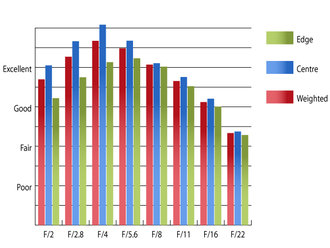 MTF@16mm |
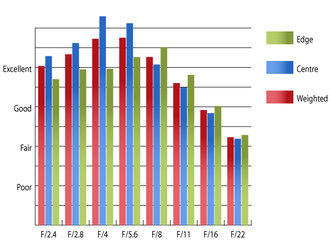 MTF@28mm |
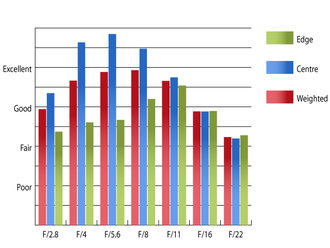 MTF@50mm |
How to read our chartsThe blue column represents readings from the centre of the picture frame at the various apertures and the green is from the edges. Averaging them out gives the red weighted column.The scale on the left side is an indication of actual image resolution. The taller the column, the better the lens performance. Simple. For this review, the lens was tested on a Samsung NX30 using Imatest. |
Chromatic aberrations are quite prevalent throughout the zoom range. At their strongest level, they exceed 1.25 pixel widths, at 16mm and maximum aperture, which may become visible, especially along high contrast areas towards the edges of the frame.
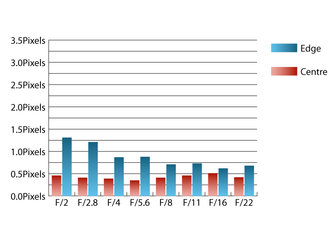 CA@16mm |
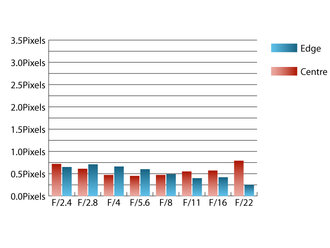 CA@28mm |
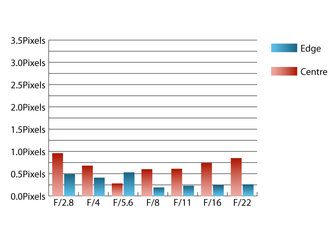 CA@50mm |
How to read our chartsChromatic aberration is the lens' inability to focus on the sensor or film all colours of visible light at the same point. Severe chromatic aberration gives a noticeable fringing or a halo effect around sharp edges within the picture. It can be cured in software.Apochromatic lenses have special lens elements (aspheric, extra-low dispersion etc) to minimize the problem, hence they usually cost more. For this review, the lens was tested on a Samsung NX30 using Imatest. |
Given the fast maximum aperture, falloff of illumination towards the corners is incredibly well controlled. At 16mm and f/2 the corners are only 0.858 stops darker than the image centre and at 50mm the corners are only 0.5 stops darker than the centre. Visually uniform illumination is achieved with the lens stopped down to f/5.6 throughout the zoom range.
Distortion is well controlled for a lens of this focal range. At 16mm 3.26% barrel distortion is present, and this is reduced to 1.1% with the lens zoomed to 50mm. The distortion pattern is uniform across the frame, so applying corrections in image editing software afterwards should be fairly straightforward.
A deep petal shaped hood is supplied with the lens, which does an excellent job of shielding the optics from extraneous light that may cause issues with flare.
Value For Money
With this lens being fairly unique in its maximum aperture and focal range, and not many third-party options being available for the Samsung NX system, it is difficult to find price comparisons for this lens. The price seems about right, when compared to lenses sporting a constant f/2.8 aperture available for APS-C DSLRs. For example, Nikon's AF-S 17-55mm f/2.8 is available for around £1050.
Add your message
Login required
Please login here or if you've not registered, you can register here. Registering is safe, quick and free.
Please login here or if you've not registered, you can register here. Registering is safe, quick and free.
photodo Stats
1102 lenses
428 MTF tests
74 in-depth photodo reviews
100+ users join each day
Help the lens community by reviewing or rating a lens today via our lens search
428 MTF tests
74 in-depth photodo reviews
100+ users join each day
Help the lens community by reviewing or rating a lens today via our lens search
Latest Lens Reviews
- Chinon 28mm f/2.8 Vintage Lens Review
- Canon EF 70-200mm f/4L IS II USM Lens Review
- Samyang AF 85mm f/1.4 EF Review
- Sigma 70mm f/2.8 DG Macro Art Review
- Samyang AF 24mm f/2.8 FE Review
- Meike 50mm f/1.7 Review
- Tamron 70-210mm f/4 Di VC USD Review
- Lensbaby Burnside 35mm f/2.8 Review
- Asahi Super Takumar 50mm f/1.4 Review
- Asahi Super-Multi-Coated Takumar 135mm f/3.5 Review
